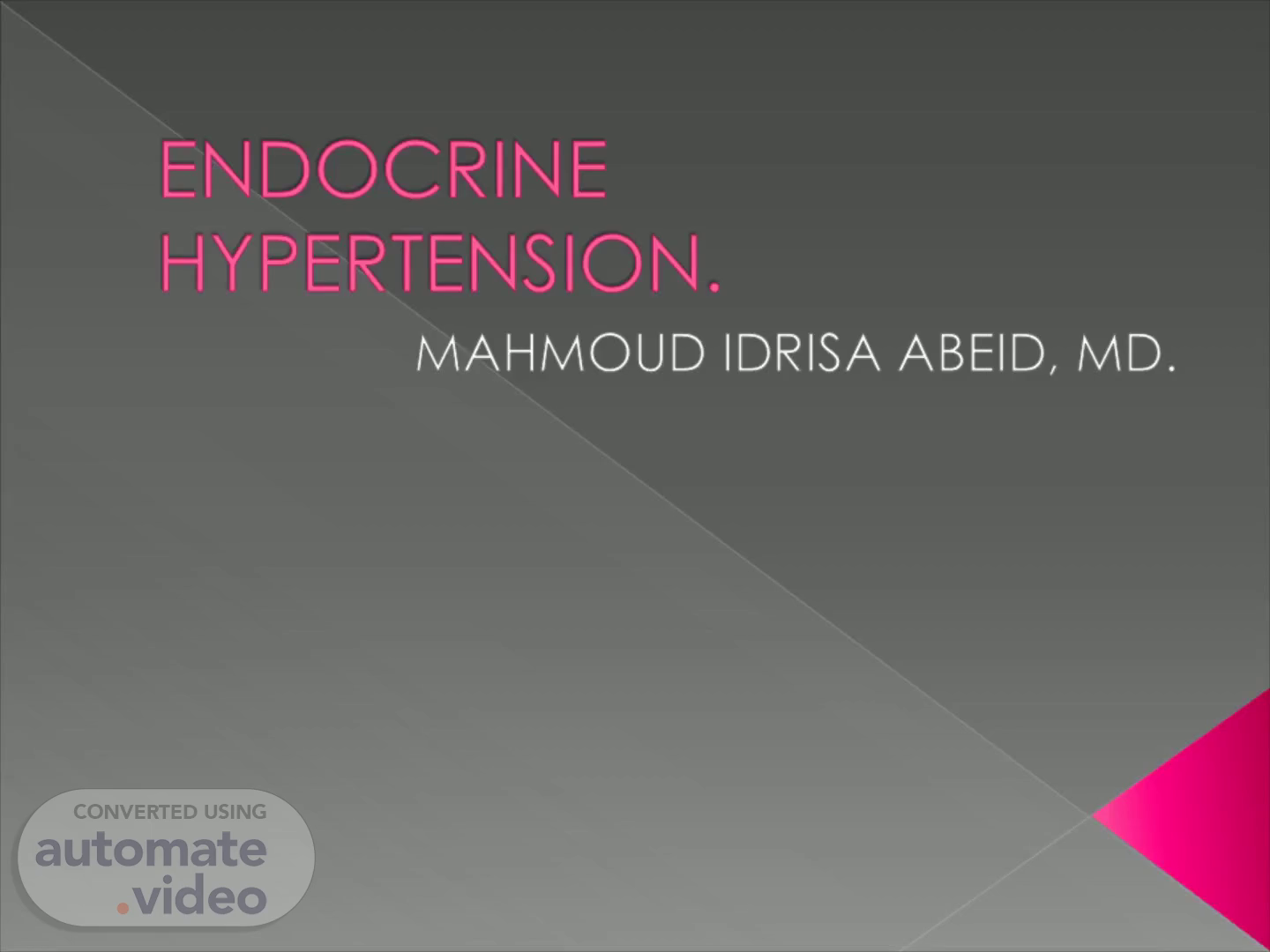
ENDOCRINE HYPERTENSION.
Scene 1 (0s)
ENDOCRINE HYPERTENSION.. MAHMOUD IDRISA ABEID, MD..
Scene 2 (7s)
OUTLINE.. Introduction to Endocrine hypertension. Causes and features of Endocrine Hypertension. Rationale for investigating Endocrine hypertension. References..
Scene 3 (17s)
Introduction.. Endocrine hypertension is elevated blood pressure due to endocrine pathologies. It makes between 5 to 10% of all hypertension cases. Most commonly suggested by poor response to conventional antihypertensive therapy in a patient on regular treatment..
Scene 4 (30s)
Introduction... Endocrine hypertension is one among secondary causes of hypertension. Suggestive features of secondary hypertension that should alert the clinician include: Onset at young age. Resistant hypertension (requiring more than 3 antihypertensive agents for control of BP). Blood pressure variations with spikes. Hypokalaemia . Familial renal diseases. Accompanying features suggestive of particular endocrine disorder..
Scene 5 (48s)
Causes of Endocrine Hypertension.. Primary hyperaldosteronism . Cushing syndrome/disease. Phaechromocytoma . Thyroid dysfunction (hyper/hypo-). Acromegaly. Congenital adrenal hyperplasia. Hyperparathyroidism. Others, including Insulin resistance and Liddle syndrome..
Scene 6 (1m 1s)
Suggestive features.. Endocrine disease Presenting features. Primary hyperaldosteronism Headache, hypokalaemia , muscle cramping and wekaness , metabolic alkalosis. Hypertension is mostly diastolic. Cushing syndrome Moon face, plethora,. Diabetes mellitus, hirsutism , central obesity, Malaise, striae , weight gain and hypertension. Phaechromocytoma Headache, diaphoresis, palpitations, paroxysmal spikes in blood pressure..
Scene 7 (1m 20s)
Suggestive feature... Endocrine disease Presenting features. Hyperthyroidism Tachycardia, tremors, anxiety, atrial fibrillation, weight loss despite gain in appetite, heat intolerance. Hypothyroidism Fatigue, edema (non pitting), bradycardia , cold intolerance, weight gain despite loss in appetite. Acromegaly Enlarged jaw, amenorrhoea , diabetes mellitus, macroglossia , sexual dysfunction, visula disturbances, headache, acral enlargement and proximal myopathy. Congenital adrenal hyperplasia Virilisation , hirsutism , amenorrhoea , hypokalaemia and tall stature..
Scene 8 (1m 43s)
Rationale.. Global burden of non communicable diseases (including hypertension) has been increasing. Mortality attributed to non communicable diseases is between 70 to 80% of all deaths. They are also among the most frequent causes of morbidity, disability and impaired quality of life..
Scene 9 (1m 58s)
Rationale.. There are groups of patients who are on regular treatment for hypertension with good adherence but poor control. Most of these patients do not get the appropriate investigations to look for the underlying cause due to resource constraints (human and diagnostic)..
Scene 10 (2m 12s)
Rationale... Studies have shown that, endocrine hypertension is associated with more cardiovascular events, more left ventricular hypertrophy and more incidences of renal damage among patients as compared to essential hypertension. Studies have also shown that most of these changes can be reversed by treatment of the underlying cause if detected and managed early..
Scene 11 (2m 30s)
Fortunately…. Almost all endocrine causes of hypertension can be cured. Those that are incurable, can be treated and managed well with proper medication. Treating the underlying causes usually results to resolution of hypertension and associated organ changes..
Scene 12 (2m 43s)
References:. Budreviciute , A., Damiati , S., Sabir , D.K., Onder , K., Schuller-Goetzburg , P., Plakys , G., Katileviciute , A., Khoja , S. and Kodzius , R. (2020). Management and Prevention Strategies for Non-communicable Diseases (NCDs) and Their Risk Factors. Frontiers in Public Health, 8(574111). doi:10.3389/fpubh.2020.57111. Koch, C., Papadopoulou-Marketou , N. and Chrousos , G.P. (2000). Overview of Endocrine Hypertension. [online] PubMed. Available at: https://www.ncbi.nlm.nih.gov/books/NBK278980/ Thomas, R.M. (2015). Endocrine hypertension: An overview on the current etiopathogenesis and management options. World Journal Of Hypertension, 5(2), p.14. doi:10.5494/wjh.v5.i2.14..
Scene 13 (3m 25s)
THANK YOU..